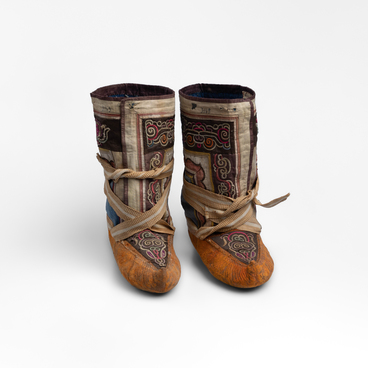The exhibition of the Vladimir Arseniev Museum of Far East History shows women’s shoes from the Chinese theater in Millionka, Vladivostok’s historical quarter.
The residents of Millionka were very unpretentious in everyday life, but they needed entertainment. Thus, there were three Chinese theaters located on the territory of one block: the Wang Ting Xing Theater on Koreyskaya Street and two theaters on Semyonovskaya Street, which the Chinese called Siyuan Datze (translated as Teatralnaya Street): the Northern Theater and the Southern Theater. The first one was spacious and generally accessible: there were seeds, nuts, sweets, husks and wrappers on the ground — this theater was visited by people who were not rich. In the Southern Theater, tea and sweets were served at the tables, members of wealthy classes spent their evenings there.
The art of theater has always been popular in China. However, for people with traditional tastes, the Chinese theater looks absolutely exotic: the orchestra is placed not in the pit, but deep in the stage, there are practically no sets, but the costumes and make-up are very colorful. The orchestra in a Chinese theater plays non-stop, and this mixture of drumming and ringing of gongs sounds a continuous cacophony to the unaccustomed ear. However, the repertoire of the theaters was varied: from plays reflecting the history of China 500 years ago, to modern and humorous plays, especially loved by the public.
The Chinese theater is known for its conventional props and acts: a whip in the hand of the actor means that he is riding, a lantern indicates that the action takes place at night; if the character is covered with a blue blanket, it implies that he has drowned.
The last director of the
Southern Theater was Jan Tui, husband of the famous Orientalist Pozdneyeva
(daughter of the founder of the Oriental Institute). This theater was often
visited by students of oriental studies: they went there not so much to admire
the acting skills as to gain language practice. In the first years of Soviet
power the theater building was used as a cinema for Chinese workers: its grand
opening took place in August 1929, when the 2nd Pacific Congress of Trade
Unions was underway in Vladivostok (the theater was named after it, but the
name didn’t stick). The Chinese movie theater did not last long: in the late
1930s, when the Chinese population in the city decreased significantly, it was
no longer needed, and the building housed the “Rodina” movie theater (which
closed in 1981).


